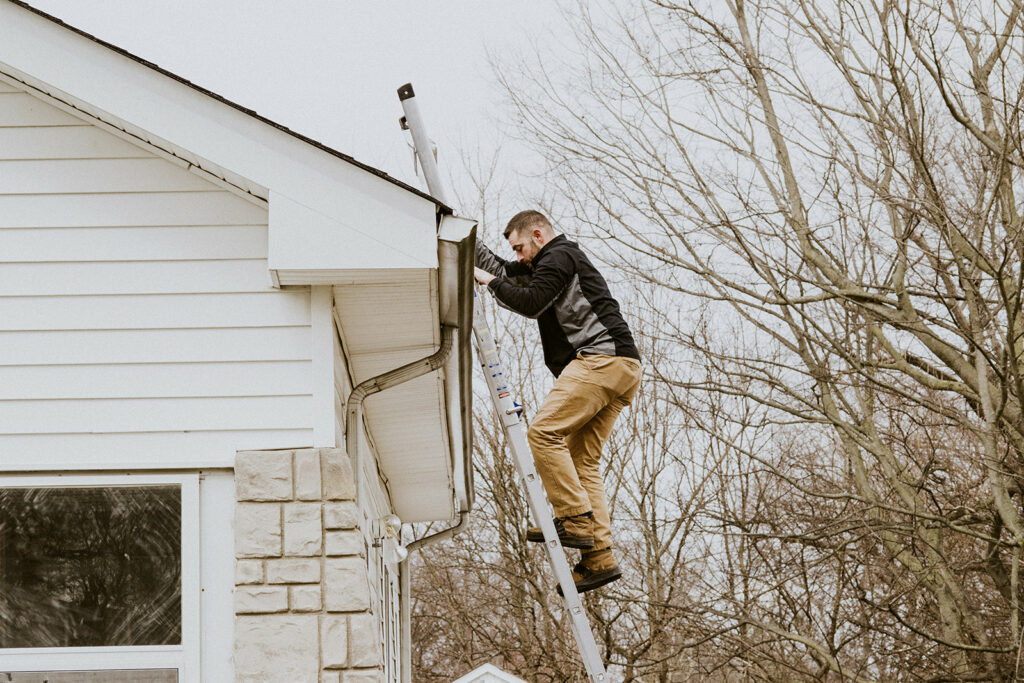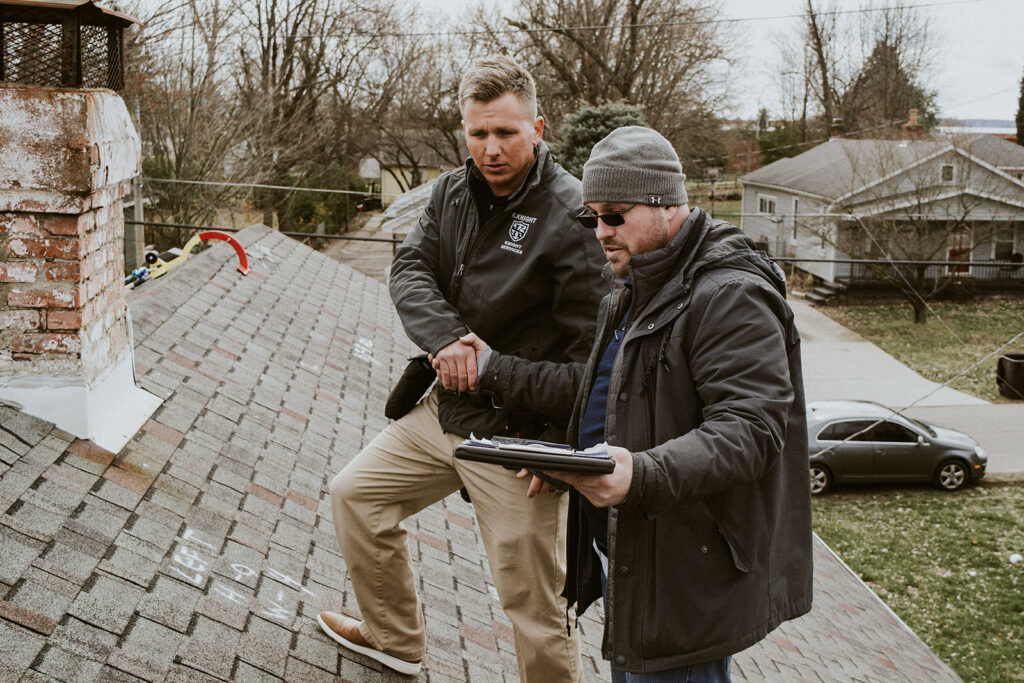A ladder assist technician plays a crucial role in the insurance industry by providing detailed assessments of property and roof damage. They assist insurance professionals, like adjusters or engineers, by inspecting roofing systems or other hard to access areas of property safely. To excel in this field, you need a combination of technical and physical skills, safety awareness, professional integrity and a passion for excellence. This guide will outline how to become a successful ladder assist technician and what it takes to thrive in this role.
1. Master Ladder/Climbing Safety
Safety is paramount when working as a ladder assist technician. Since most of your work will be performed at height, ensuring both your safety and that of others is essential.
- Proper Ladder Setup: Ensure your ladder is on a stable surface and set at an appropriate angle (typically, a 4:1 ratio for height to base distance).
- Three-Point Contact: Always maintain three points of contact with the ladder.
- Check Weather Conditions: Avoid working on rooftops during dangerous weather or unsafe conditions such as morning frost/dew.
- Inspect Equipment Regularly: Ensure your ladder and other tools are in good condition. Always visually inspect your gear before each climb.

2. Understand Roofing Structures
A strong understanding of roofing systems is essential for a ladder assist technician.
- Learn Roofing Terminology: Be familiar with terms like ridge, eaves, rakes, hips, flashing, and valleys. Pitch, eave depth, cohesive seal, mechanical fasteners, etc.
- Understand Roofing Systems: Recognize various roof types and materials. Gable, hip, gambrel, mansard, saltbox are some of the most common roof types. Shingles, metal panels, clay/concrete/slate tiles, modified bitumen, TPO, PVC, EPDM are some of the most common roofing material types.
- Get Training: Consider certifications to increase your expertise. There are many certifications to consider, but the HAAG residential course is a great place to start, and required for our technicians.
3. Document Accurately
Accurate documentation is critical to ensuring insurance adjusters can assess claims properly.
- Photography Skills: Take clear, detailed photos. Use background/foreground objects to provide perspective and depth, photograph non damaged areas to provide baseline condition, provide ample justification for the adjuster to determine coverage. Your photos are your data and your justification. Don’t let your photos be ruined by sun glare, shadow placement, angle, blurriness, distance.
- Detailed Notes: Record your findings with specifics on the type and cause of damage. Use arrows/circles to draw attention to specifics in photographs, correlate locations of

4. Work Well with Others
Strong interpersonal skills are essential in this role, as you’ll often work alongside adjusters, contractors, and homeowners.
- Professionalism: Always be courteous and respectful in your interactions with customers, policyholders, contractors, etc.
- Clear Communication: Always defer to the acting adjuster to answer the questions of contractors or policyholders as they are the deciding authority. If they ask, be ready and able to explain your findings in a way that non-technical people can easily understand.
- Collaborative Attitude: Be flexible and ready to work efficiently with others on-site. Allow contractors to indicate what they would like photographed/presented to the adjuster as potential damage, even if you disagree with their assessment.

5. Stay Physically Fit
The physical demands of being a ladder assist technician require you to maintain a certain level of fitness.
- Strength and Balance: Strengthen your core, arms, and legs for stability while climbing ladders. Knees and ankles need to be strong in order to deal with prolonged steep pitch.
- Flexibility: Stretch regularly to ensure agility when navigating rooftops. Bending, stooping, kneeling, reaching are regular movements during an inspection.
- Hydration and Rest: Staying hydrated and rested will help you perform at your best. Know your limits and the signs of dehydration/heat exhaustion, take action immediately when you see the warning signs.
6. Invest in the Right Tools
Having the proper tools can make your job easier and safer.
- High-Quality Ladder: High quality adjustable and/or articulating extension ladders are essential. The most capable techs have multiple ladders at their disposal to be ready/able to handle the most challenging of inspections, these techs typically carry a 21 ft. articulating ladder and a 32/40 ft. extension ladder.
- Personal Protective Equipment (PPE): Cougar Paws, GOAT Steep Assist/RidgePro, rope and harness, and Pitch Hoppers are vital for safe steep access.
- Measuring Tools: Tape measures, laser tape measure, moisture meters, and other tools for accurate measurements during inspections.
- Shingle/Metal Gauges: It’s vital to be able to accurately identify material makeup during an inspection. Although materials may look very similar, pricing can vary based on the exact material thickness/rated lifespan.

7. Punctuality
Being on time is critical in the ladder assist business. Insurance adjusters, roofing contractors, and homeowners often operate on tight schedules. Your ability to show up on time builds trust and demonstrates professionalism. Turning in finalized documentation is also a critical function of technicians, customers rely on our data to handle claims in a timely manner. The industry standard goal is to have documentation finalized and submitted within 24 hours of the inspection.
- Respect Deadlines: Always arrive early or on time to appointments. Submit documentation within 24 hours of inspection. Be responsive to internal/external customers that are working with your data.
- Efficient Planning: Map out routes and consider traffic or weather delays ahead of time. Communicate with your point of contact the day before the inspection and before arriving at the loss location.
- Consistency: Being punctual and efficient consistently shows your reliability and makes you more likely to be called back for future work.
8. Discretion
In your role as a ladder assist technician, you may encounter sensitive situations such as personal property damage, insurance disputes, or other private matters. Practicing discretion is key to maintaining professional integrity.
- Confidentiality: Do not discuss client details with anyone other than the client. Do not discuss client specific protocol or process with anyone other than the client.
- Respect Privacy: Handle property and sensitive information with care. Treat each claim as if it were your own property, have respect for people’s privacy.
- Professional Boundaries: Be mindful of conversations with clients and colleagues to maintain trust. Do not discuss your gripes/complaints directly with a client, discuss these things in private with a member of management.
9. Willingness to Travel
The nature of the job often requires you to travel to various locations. Sometimes, this may include remote or hard-to-reach areas.
- Flexibility in Locations: Techs must be willing to cover a decent sized radius from their home location, we unfortunately cannot make the damaged properties travel to us.
- Travel Readiness: Techs should be capable and ready for over the road work when a large storm event happens. Hurricanes, hail events, and tornado outbreaks produce spikes in claim volume in a very short period of time, so techs should be ready to take on larger inspection volume as needed.
- Vehicle Maintenance: Keep your vehicle in good working condition. Change oil regularly, monitor tire health, avoid costly and lengthy down time during peak season.

10. Cyclical Nature of the Business
The ladder assist industry is subject to fluctuations depending on the season and weather conditions, such as storm seasons or times when claims peak.
- Understand Busy Seasons: Roofing inspections tend to increase after storms or extreme weather. The busiest period of the year is typically March-September. Be prepared for long hours during these periods.
- Slow Periods: Work may be slower in off-seasons, so manage your time and finances accordingly. Some of the most successful techs have side hustles or juggle multiple avenues of income during slow seasons.
- Stay Available: During peak periods, being ready and available can lead to more work and opportunities. The most successful techs maintain at least 5 days of availability per week during the busy season.
11. Preparedness
Being well-prepared for every job will not only help you be more efficient but will also help avoid delays or mistakes.
- Pre-Job Research: Understand the specific needs of each assignment ahead of time. Research the property via Google Earth to understand the roofing system pitch/height, the need for fall protection, and ladder requirements.
- Point of Contact: Always reach your point of contact the day before to introduce yourself, discuss your intentions and role in the claims process, and set expectations for your time of arrival.

12. Coachability
Being coachable means being open to learning and improving, which is essential for growth in this role.
- Take Feedback: Be receptive to feedback from insurance adjusters, contractors, and colleagues.
- Eagerness to Learn: Take the initiative to learn new methods and techniques, especially as technology and industry standards evolve.
- Adaptability: Be willing to adjust your methods and approach as needed to meet the specific demands of different customers.
Conclusion
Being a successful ladder assist technician requires a combination of technical skills, safety awareness, professionalism, and flexibility. By mastering these elements—safety, punctuality, preparedness, discretion, coachability, and willingness to travel—you can thrive in this career. The cyclical nature of the business means you’ll need to stay ready for busy periods and take advantage of slow times to improve your skills. With these strategies, you can provide exceptional support and ensure your long-term success in this field.
Think you’re a good fit? See open positions today or share your resume!










Recent Comments